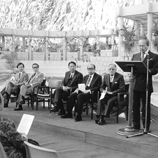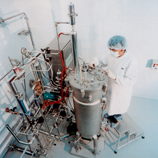

1983 - 1992
The ten years between 1983 and 1992 make for a relatively quiet decade in the University's early history, as the thundering noises of the bulldozers and the piling machines had given way to powerful music by Bach and Messiaen from the organ in the Chung Chi Chapel, maybe equal in decibels but certainly a lot more pleasing to the ear and to the intellectual mind. The campus had, by the dawn of the University's third decade, been more or less licked into its present shape, with the major teaching, administrative and residential facilities in place, and the rugged terrain tamed and harnessed in readiness for zoning and development in the years to come.
By 1983, the Chinese University had become well known enough among the citizens of Hong Kong for being a place where their children might 'have a good education, and get a good job afterwards'. With the transition of Hong Kong's economic emphasis from manufacturing and entrepot trade to the service industries, the 1980s were a golden age for degree-holders, with an enviable abundance of white-collar jobs. The Chinese University responded to the needs of the community very well during this decade, and supplied commercial firms, financial institutions, schools, and the Government with young blood of the highest quality. The 1980s also saw the University beginning to augment the ranks of the upper echelon of the Civil Service on a regular basis, there being a steady stream of fresh graduates entering the Administrative Grade every year. On the other hand, the University was true to its academic mission, and research was carried out with enthusiasm and vigour in various disciplines. In 1983, the first PhD of CUHK received his round hat.
While the Graduate School was fast beefing up its programmes and turned out star graduates who would, in due course, illumine the academic firmament worldwide, another excitement was quietly brewing in a far corner of Shatin. The first graduates of the newly established Faculty of Medicine took their degrees in 1986, bringing to fruition a dream of the University's founding fathers, and fulfilling their promise that the University would faithfully serve the community by providing high-calibre professionals in areas where they were most needed. That promise was further enhanced with the establishment of the Department of Nursing in 1991 (renamed The Nethersole School of Nursing in 2002) and the School of Pharmacy in 1992. On the industrial front, the Chinese University, which played a pioneering role in introducing electronic engineering to higher education in Hong Kong, established its Faculty of Engineering in 1991.
As the University grew in stature and reputation among the important seats of learning around the world, the need for expansion was keenly felt and, following the best traditions in collegiate institutions, a new College was to be built, with a generous endowment from Sir Run Run Shaw. The foundation stone of Shaw College was laid in 1987, and its doors were opened in 1990. In the meantime the University continued to work hard to secure its position among the leading institutions of higher learning in the region, and landmark events during those years included an important conference on the modernization of China in 1983, the academic exchange agreements signed with the Academia Sinica in 1986, and the first of the University's graduates winning the prestigious Rhodes Scholarship in 1987.
In 1987, Dr. W. Szeto, the architect who laid down the master plan of the campus two decades ago, donated 'The Gate' by the famous sculptor Ju Ming and 'The Forum' fountains to the University. Both structures continue to adorn the University Square to this day, at the same time serving as permanent reminders to successive generations of graduates of the time worthily spent on their well-beloved campus. In 1987 Professor Ma Lin, the second Vice-Chancellor, retired from the helm of the University after nine years of service of unsurpassed merit, and was succeeded by Professor Charles K. Kao, who inaugurated a new chapter in the University's advancement to international fame and exalted standing.
During the late 1980s a number of new buildings had emerged on campus that featured deviations from the angularity and monochrome of the earliest buildings, and they provided alternatives to the much-loved and well-executed fair-faced concrete that had been a mark of distinction of the CUHK campus. For both utility and aesthetics, the new buildings were less monolithic and monumental, but more personable and friendly. The Chinese University campus was beginning to mature, with the gradual appearance of a variety of architectural styles and colours.
The decade also saw a lot more understanding and exchange of views and opinions between the student body and the university management. At the same time, services to alumni commenced on a large scale, and alumni home-coming began to be organized as grand affairs, drawing thousands of graduates back to the campus with their families and bringing vivid colours to life on campus.
The 1980s were the years during which the Chinese University showed itself coming of age, and it was also a time when the University consolidated its strengths and resources to prepare for the achievements that were to come in the next twenty years. In terms of contribution to community growth and development, Chinese University graduates showed greater diversification in their career destinations during the decade, and became more evenly distributed in the three main sectors of the local employment market, education, commerce and the public services whereas, in the years before, there appeared to be an over-reliance on jobs in the teaching field. Socio-economic factors such as the decrease in the number of school-age children, and the booming opportunities in the tertiary sector of the economy, no doubt all played a part, but the University had also made great efforts to instil the concepts of career planning into graduating students, to prepare them for the early employment life, and to garner the support of major recruiters.
































CUHK Research | CUHK: Focus at 50 | The Call of CUHK Colleges
CUHK Home | ISO Home | Contact Us | Disclaimer | Privacy Policy
Copyright © 2023. All Rights Reserved. The Chinese University of Hong Kong.